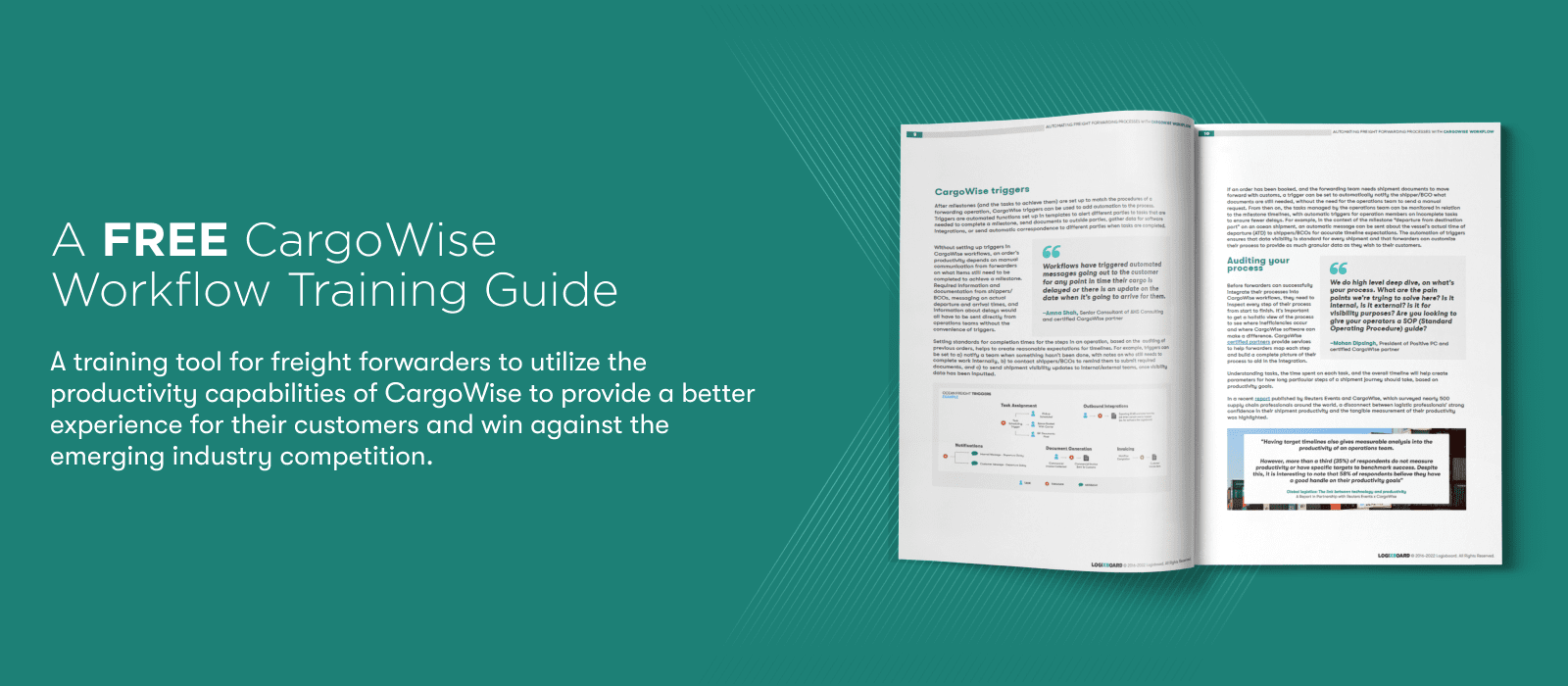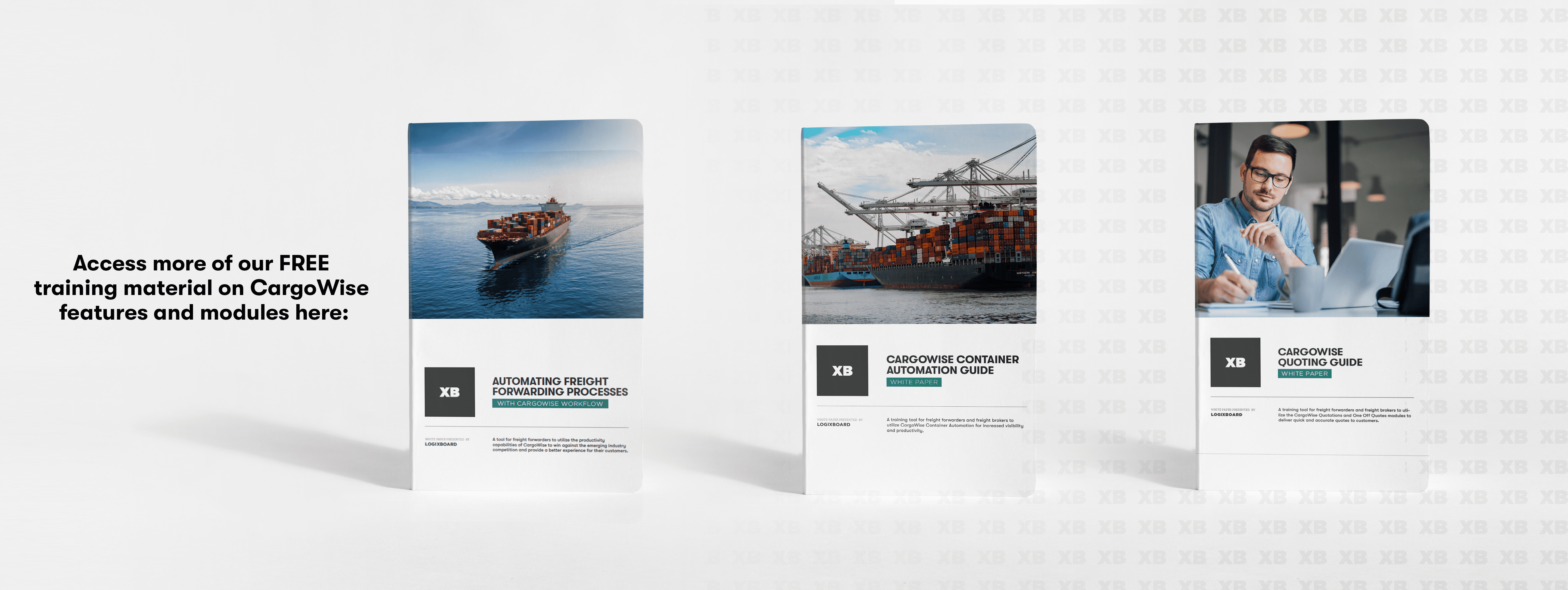In this article
Direct communications with an assigned ocean carrier is necessary for a logistics service provider during the management of a shipment or container.
CargoWise’s Ocean Carrier Messaging feature gives their users capabilities to send Booking Requests, Shipping Instructions, and Verified Gross Container Weight Messages (eVGM) to the Ocean Carrier digitally (directly or through a service provider).
On the flip side, the Ocean Carrier messaging can receive booking confirmations, booking request acknowledgments, and shipping instruction acknowledgments from carriers to CargoWise users.
These messaging features help provide a more productive and streamlined workflow for CargoWise users by offering functionality to handle communications directly within the system.
With Logixboard, real-time exceptions alerts, shipment notifications, and in-app messages keep you and your customer informed in real-time, eliminating back-and-forth emails and phone calls.
Logixboard Pitch
Utilizing Ocean Carrier Messaging
Users can access Ocean Carrier Messaging using Form Builder in an operations job.
From there, the user can use Form View for validation, review, editing, and then submission of messaging data to carriers. Each of the three outgoing carrier messaging types (Booking Requests, Shipping Instruction, and eVGM) are sent directly from the forms within CargoWise.
After form submission, CargoWise creates a Universal Shipment XML that is sent via eHub, and mapped according to the specific Carrier, NVOCC, or Service Provider’s requirements.
Connecting to an Included Carrier or NVOCC
By raising an eRequest, the user can form a messaging connection on CargoWise between their company and any of the included ocean carriers/NVOCCs. Selecting “CR9 – Service Request” for the criticality and “MSG – Messaging Configuration” for the service on the request will ensure the connection is set up for full functionality of the Ocean Carrier Messaging feature.
On the Ocean Carrier Messaging Connection form, users will indicate which branches and carriers they wish to connect with. WiseTech Global’s eHub will guide users through the connection process by utilizing a combination of direct connections through multiple service providers in order to provide users with the best possible Ocean Carrier coverage. To connect, some ocean carriers need a recent Bill Of Lading, Booking, or Contract Number, while others require a service provider’s account.
Carriers can that already have established connections through CargoWise and WiseTech are broken into three categories: carriers with established connections through WiseTech, NVOCCs with established connections through WiseTech, and NVOCCs that are also CargoWise users (a CargoWise to CargoWise connection).
Carriers Directly Connected:
- ANL Container Line
- APL (American Presidents Line)
- CMA-CGM
- CNC Line (Cheng Lie Navigation)
- Evergreen
- Gold Star Line
- Hapag-Lloyd
- HMM (Hyundai Merchant Marine)
- Laurel Navigation • Maersk Sealand
- MCC Sealand Asia
- MSC (Mediterranean Shipping Co)
- ONE (Ocean Network Express)
- Seago Sealand Europe
- Sealand Americas
- Seth Shipping
- SM Lines
- Yang Ming Marine Transport.
- ZIM Shipping Line
NVOCCs Directly Connected:
- AGS World
- AMASS
- Carotrans
- CWT Globelink
- ECU World
- Odyssey Shipping
- Vanguard Logistics
- WWA – WorldWide Alliance
NVOCCs with Cargowise to Cargowise Connections:
- Alliance Shippers, Inc
- AEL Berkman Forwarding
- AGS World
- Bold Logistics
- Chemlogix Global
- Consol Alliance
- Consolcargo
- Contra Consolidations
- Craft Multimodal
- CTL Charter Link
- EPL International
- Logwin
- Mahe Neutral Shipping
- Merzario
- NVO Consolidation
- Oceanbridge Shipping
- Seino Logix Co
- Sevenlog Belgium
- United Shipping & Logistics
Connecting to an External Carrier or NVOCC
By raising an eRequest, the user can also form a messaging connection on CargoWise between their company and an Ocean Carrier or NVOCC that is not listed on the Ocean Carrier Messaging Connection. Selecting “CR7 – Estimate / Quote Request” for the criticality and “FOR – Forwarding” for the Menu Section on the request will ensure the connection is set up for full connectivity.
Note: Connection to carriers not yet supported requires time to establish contact, develop mapping, and complete testing.
Set Up of Carrier or NVOCC Through Service Providers
For ocean carriers connected through service providers (like INTTRA, InforNexus, or CargoSmart) the setup process is slightly different for each.
When setting up through INTTRA, CargoWise users must register with the carrier/NVOCC independently to send and receive the common carrier messaging types. CargoWise account representatives can map the user’s eHub ID with their INTTRA Alias if an account is already established with INTTRA through the user.
For CargoSmart Carriers, users must raise an eRequest per the desired carrier. Carriers require a recent reference number (e.g. Booking Number, Bill of Lading number, etc.) for each company a user needs a connection for. In the eRequest, users must provide each Company Code, Branch Code, Address, and Contact. Branch Codes are found under Maintain, User Admin, and then under Branches next to the branch name.
When connecting through InforNexus, authorization via an Authorization Letter Template is required. Users will need to raise a CR9 eRequest and attach the Authorization Letter to the incident. In the eRequest, users must provide each Company Code, Branch Code, Address, and Contact.
Notifications and Trigger Actions for Ocean Carrier Messaging Events
CargoWise Ocean Carrier Messaging users are able to reach higher levels of productivity and efficiency in their operations when establishing related notifications and triggers in their workflows.
Ocean Carrier Messaging events are readable by these workflows to add automation of message events into internal operations when these correspondences impact parts of a shipment/container journey.
- MSN – Message Sent
- ISN – Interchange Sent
- IRJ – Interchange Rejected
- IRA – Interchange Receipt Acknowledged
- MRJ – Message Rejected
- MPP – Message Pending Processing
- MAA – Message Accepted
A couple of examples would be to set up a notification or trigger reaction to alert users if a booking request is rejected by a carrier, to alert users if a technical issue happens when sending a message to a carrier, or alert a user if a booking is confirmed.
Final thoughts
As logistics service providers look for ways to scale their work (without sacrificing service quality) using digitization, utilizing communications and automation already ingrained in their TMS can help them get ahead.
Want to learn more about adding productivity to your internal operations on CargoWise? Check out our training guides for added automation and efficiency:


